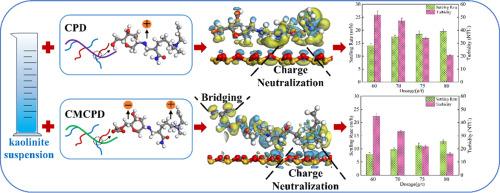Flocculation behavior and interaction mechanism of carboxymethyl chitosan/chitosan-based graft flocculants on kaolinite (00−1) surface: Experiment and DFT calculation
IF 6.3
2区 工程技术
Q1 ENGINEERING, CHEMICAL
引用次数: 0
Abstract
Chitosan-based flocculants represent a highly promising alternative to industrial synthetic organic flocculants, offering exceptional environmental friendliness and efficiency. The carboxymethyl chitosan-graft-poly (acrylamide-dimethyl diallyl ammonium chloride) (CMCPD) and chitosan-graft-poly (acrylamide-dimethyl diallyl ammonium chloride) (CPD) were successful synthesized using UV-induced graft polymerization. The flocculation behavior and mechanism of these two chitosan-graft-copolymers on kaolinite suspension were investigated employing settling test and density functional theory calculation of the structural units of CMCPD and CPD on the kaolinite (00–1) surface. Experimental results indicated that the CMCPD had a greater settling rate of 19.47 m/h at the dosage of 80 g/t than CPD (12.96 m/h). The simulation results revealed distinct adsorption conformations of CMCPD and CPD units on the kaolinite (00–1) surface, characterized by an inclined posture and a horizontal posture, respectively. The stable adsorption of CPD can be attributed to the electrostatic attraction, which is evidenced by its higher adsorption energy (−4.74 eV) on the kaolinite (00–1) surface compared to CMCPD (−3.63 eV). It should be noted that both the adsorption energy and conformation play crucial roles in determining the flocculation efficiency of a flocculant. The inclined adsorption of CMCPD not only displayed electrostatic attraction but also enhanced its bridging ability, leading to a rapid increase in floc size and settling rate. The settling performance was significantly influenced by the bridging effect exerted by flocculants. This study holds great significance for the advancement of novel and efficient flocculant development.

羧甲基壳聚糖/壳聚糖基接枝絮凝剂在高岭石(00-1)表面的絮凝行为及相互作用机理:实验与 DFT 计算
以壳聚糖为基础的絮凝剂是工业合成有机絮凝剂的替代品,具有极高的环保性和效率。利用紫外光诱导接枝聚合法成功合成了羧甲基壳聚糖接枝聚(丙烯酰胺-二甲基二烯丙基氯化铵)(CMCPD)和壳聚糖接枝聚(丙烯酰胺-二甲基二烯丙基氯化铵)(CPD)。通过沉降试验和高岭石(00-1)表面 CMCPD 和 CPD 结构单元的密度泛函理论计算,研究了这两种壳聚糖接枝聚合物在高岭石悬浮液上的絮凝行为和机理。实验结果表明,当 CMCPD 的用量为 80 g/t 时,其沉降速度为 19.47 m/h,高于 CPD(12.96 m/h)。模拟结果表明,CMCPD 和 CPD 单元在高岭石(00-1)表面的吸附构象截然不同,分别表现为倾斜姿态和水平姿态。与 CMCPD(-3.63 eV)相比,CPD 在高岭石(00-1)表面上的吸附能(-4.74 eV)更高,这表明 CPD 的稳定吸附归因于静电吸引。应该指出的是,吸附能和构象在决定絮凝剂的絮凝效率方面都起着至关重要的作用。CMCPD 的倾斜吸附不仅显示出静电吸引力,还增强了其架桥能力,从而使絮体尺寸和沉降速度迅速增加。絮凝剂的架桥效果对沉降性能有很大影响。这项研究对于推动新型高效絮凝剂的开发具有重要意义。
本文章由计算机程序翻译,如有差异,请以英文原文为准。
求助全文
约1分钟内获得全文
求助全文
来源期刊

Journal of water process engineering
Biochemistry, Genetics and Molecular Biology-Biotechnology
CiteScore
10.70
自引率
8.60%
发文量
846
审稿时长
24 days
期刊介绍:
The Journal of Water Process Engineering aims to publish refereed, high-quality research papers with significant novelty and impact in all areas of the engineering of water and wastewater processing . Papers on advanced and novel treatment processes and technologies are particularly welcome. The Journal considers papers in areas such as nanotechnology and biotechnology applications in water, novel oxidation and separation processes, membrane processes (except those for desalination) , catalytic processes for the removal of water contaminants, sustainable processes, water reuse and recycling, water use and wastewater minimization, integrated/hybrid technology, process modeling of water treatment and novel treatment processes. Submissions on the subject of adsorbents, including standard measurements of adsorption kinetics and equilibrium will only be considered if there is a genuine case for novelty and contribution, for example highly novel, sustainable adsorbents and their use: papers on activated carbon-type materials derived from natural matter, or surfactant-modified clays and related minerals, would not fulfil this criterion. The Journal particularly welcomes contributions involving environmentally, economically and socially sustainable technology for water treatment, including those which are energy-efficient, with minimal or no chemical consumption, and capable of water recycling and reuse that minimizes the direct disposal of wastewater to the aquatic environment. Papers that describe novel ideas for solving issues related to water quality and availability are also welcome, as are those that show the transfer of techniques from other disciplines. The Journal will consider papers dealing with processes for various water matrices including drinking water (except desalination), domestic, urban and industrial wastewaters, in addition to their residues. It is expected that the journal will be of particular relevance to chemical and process engineers working in the field. The Journal welcomes Full Text papers, Short Communications, State-of-the-Art Reviews and Letters to Editors and Case Studies
 求助内容:
求助内容: 应助结果提醒方式:
应助结果提醒方式:


